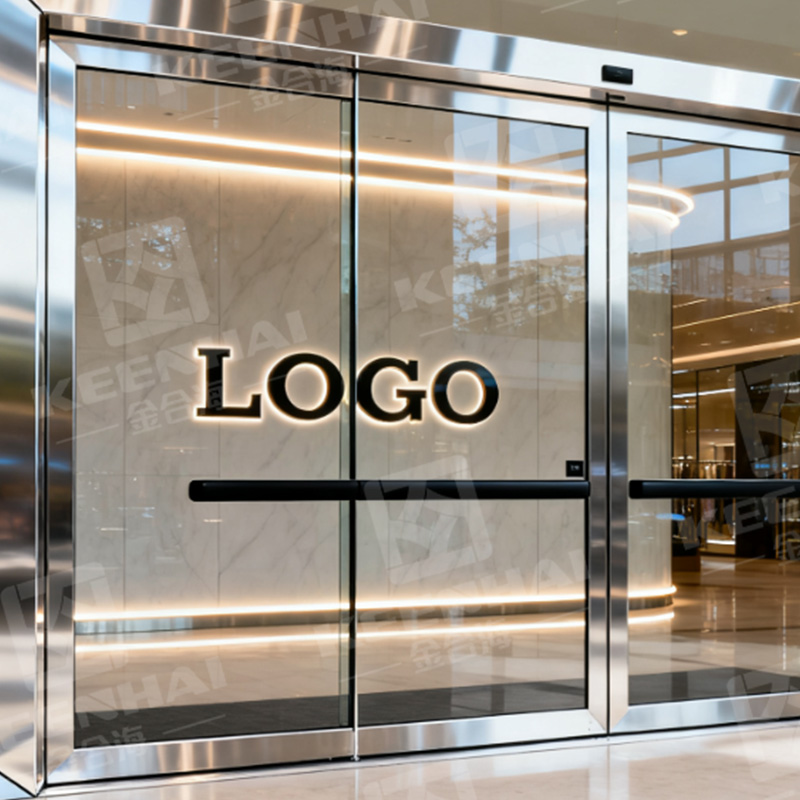A cladding panel is an outer layer used to cover a building’s structure, mainly for protection and design. It shields walls from rain, wind, and sunlight while giving the exterior a polished look. Materials range from stainless steel and aluminum to stone, making it both functional and stylish.
1.Definition of a Cladding Panel
1.1 Basic Concept
A cladding panel is a non-structural layer fixed to the exterior or interior surface of a building element, mainly for protection and decoration. Unlike load-bearing walls, these panels don’t support the structure; instead, they serve as a protective skin that shields the core material from rain, wind, and temperature changes. In modern projects, you’ll often see them on façades, lobbies, and even parking structures, where aesthetics and durability are equally important.
For example, a shopping mall might use large aluminum panels on its façade to give a sleek, uniform look, while an office tower could install a Πάνελ επένδυσης στήλης to conceal concrete supports and match the overall design theme. In such cases, the panel becomes both a practical cover and a visual upgrade, blending strength with architectural appeal.
1.2 Key Characteristics
When architects or builders choose cladding panels, they usually evaluate a few specific properties that directly impact performance:
-
Material Variety – Panels can be fabricated from aluminum, natural stone, glass, ceramic, or composite systems. Each option has a distinct appearance and maintenance profile.
-
Αντοχή – High-quality cladding resists corrosion, fading, and weathering. For instance, stainless steel cladding can last decades with minimal upkeep, making it popular in airports and metro stations.
-
Thermal and Acoustic Benefits – Depending on the system, panels may enhance insulation, reduce energy costs, or dampen outside noise.
-
Design Flexibility – Panels are available in different shapes, thicknesses, and finishes, which gives designers freedom to match both traditional and modern styles.
-
Ευκολία εγκατάστασης – Many systems are engineered with interlocking joints or concealed fasteners, allowing workers to mount them faster and with fewer visible seams.
To illustrate, here’s a quick comparison of common materials used for cladding panels:
| Υλικό | Durability (Years) | Maintenance Level | Typical Applications |
|---|---|---|---|
| Aluminum | 20–30 | Low | High-rise façades, shopping malls |
| Natural Stone | 40+ | Μέσον | Luxury hotels, monuments |
| Γυάλινα Πάνελ | 15–25 | Medium–High | Office towers, curtain wall systems |
| Ανοξείδωτο ατσάλι | 30–50 | Very Low | Airports, hospitals, transport hubs |
| Composite Materials | 15–20 | Μέσον | Retail stores, residential balconies |
In premium interiors, designers often specify Επένδυση κολώνας από ανοξείδωτο χάλυβα for hotel lobbies or high-end commercial atriums. This approach hides rough structural elements while projecting a polished, upscale image. You can explore more about these options directly from specialized stainless steel column cladding solutions.

2.Common Materials Used in Cladding Panels
2.1 Metal (Aluminum, Stainless Steel)
Metal is one of the most widely used options for cladding because of its strength and sleek finish. Aluminum panels are lightweight, easy to cut on-site, and resistant to rust, which is why they often appear on airport terminals or high-rise façades. In contrast, stainless steel cladding provides a premium, long-lasting surface that can withstand heavy foot traffic and harsh climates. For example, metro stations and hospital lobbies often choose stainless steel because it is easy to sanitize and holds up well over decades.
In commercial interiors, designers sometimes hide bulky support structures using a Επένδυση κολώνας από ανοξείδωτο χάλυβα system. This transforms plain concrete into a polished architectural element that complements glass walls and marble floors.
Here’s a comparison of aluminum and stainless steel panels based on key performance factors:
| Χαρακτηριστικό | Aluminum Panels | Πάνελ από ανοξείδωτο χάλυβα |
|---|---|---|
| Weight | Very light | Heavier |
| Αντοχή στη διάβρωση | Excellent (with coating) | Excellent |
| Maintenance Needs | Low | Very low |
| Lifespan | 20–30 years | 30–50 years |
| Common Applications | Exterior façades, roofing | Lobbies, transport hubs, hospitals |
2.2 Stone and Marble
Stone and marble have been used for centuries as cladding materials, particularly in government buildings, luxury hotels, and cultural landmarks. Natural stone offers a timeless appearance, and marble is especially popular in creating grand entrances or decorative columns. However, these materials are heavy and require precise installation, often with reinforced anchoring systems. A practical example is the use of marble cladding in five-star hotel atriums, where the combination of lighting and polished stone creates a high-end atmosphere.
2.3 Wood and Composite
Wood panels add warmth and a natural feel to both residential and commercial projects. Architects often specify cedar or teak because they age gracefully and can handle outdoor exposure when treated. Composite panels, which combine wood fibers with resins or polymers, are gaining popularity because they mimic the look of timber while offering better moisture resistance. You’ll frequently see composite cladding used in modern townhouses, where homeowners want a balance of style and lower maintenance.
2.4 Glass and Other Options
Glass cladding panels are common in contemporary skyscrapers. They allow daylight to flood into office spaces while still providing weather protection. Beyond glass, other specialty materials include ceramics, terracotta tiles, and fiber cement boards. Each has its niche: terracotta is often chosen for cultural or academic buildings, while fiber cement boards are favored in cost-sensitive housing developments because they are durable and relatively affordable.
In some modern designs, structural supports are wrapped with a Column Cladding Panel, combining glass façades with sleek metal finishes to give the building a cohesive, modern identity.

3.Functions and Benefits of Cladding Panels
Cladding panels are more than just a design choice; they play a critical role in improving the appearance, protection, and performance of any building. Let’s break down their key benefits:
| Benefit | Description |
|---|---|
| Aesthetic Enhancement | Panels come in various finishes, colors, and patterns, giving buildings a modern, premium look while matching architectural style. |
| Protection and Durability | They act as a shield against rain, wind, UV rays, and pollution, extending the lifespan of the building structure. |
| Insulation & Energy Efficiency | High-quality panels improve thermal and acoustic insulation, helping to reduce energy bills and maintain indoor comfort. |
3.1 Aesthetic Enhancement
One of the most immediate benefits of cladding panels is their ability to transform plain structures into visually appealing features. A concrete column in a hotel lobby may look harsh and unfinished, but once wrapped with a Πάνελ επένδυσης στήλης, it becomes an elegant centerpiece that matches the flooring, lighting, and overall interior design. On commercial façades, aluminum or stainless steel panels are often used to create a sleek, modern look, while stone or wood cladding can highlight a natural or traditional aesthetic. This flexibility allows architects to align the building’s appearance with its intended identity, whether it’s a corporate office tower or a boutique retail store.
3.2 Protection and Durability
Beyond looks, cladding plays a vital role in shielding the building’s structural core. Panels act as a barrier against rain, UV rays, wind, and even pollutants in urban environments. In coastal regions, for instance, stainless steel cladding has proven highly effective because it resists salt corrosion much better than untreated materials. Similarly, glass cladding on high-rise towers is engineered to withstand high wind loads without cracking or detaching. These protective qualities extend the lifespan of the structure by reducing direct exposure to damaging elements.
3.3 Insulation and Energy Efficiency
Modern cladding systems are also designed to improve thermal and acoustic performance. By creating a buffer zone between the structural wall and the external environment, panels help regulate indoor temperatures and reduce reliance on heating or cooling systems. In practical terms, a shopping mall with well-installed composite cladding can cut down energy costs while also providing a quieter indoor environment by blocking external noise.
When combined with reflective finishes, such as polished stainless steel products, cladding can redirect sunlight and prevent excessive heat absorption, which is particularly valuable in warm climates. Developers looking for both energy savings and durability often prefer these solutions because they offer long-term returns on investment.

4.Types of Cladding Panels
Cladding panels are not one-size-fits-all; they are designed for different purposes depending on where they are applied. From the exterior of tall office buildings to the columns inside luxury hotels, each type serves a unique role in construction and design.
4.1 Exterior Wall Cladding
Exterior wall cladding is the most common application. In modern architecture, you’ll often see stainless steel panels on skyscrapers or large shopping malls. They don’t just create a sleek finish but also provide weather resistance against heavy rain, heat, and UV exposure.
A real-world example can be found in coastal cities where salt in the air corrodes traditional building materials quickly. By using metal-based wall cladding, developers ensure the façade remains intact and attractive for decades without constant repainting. Compared to brick or wood, steel panels require far less maintenance and offer stronger durability.
| Υλικό | Αντοχή | Συντήρηση | Visual Appeal |
|---|---|---|---|
| Brick | Μέσον | High (repainting, sealing) | Traditional, rustic look |
| Wood | Low to Medium | Very High (treatment, staining) | Warm, natural aesthetic |
| Ανοξείδωτο ατσάλι | Very High | Low | Modern, reflective finish |
4.2 Interior Decorative Cladding
Interior decorative cladding is used where design and ambiance matter most—think of luxury hotel lobbies, airports, or high-end restaurants. Panels with polished or brushed finishes instantly elevate the space, giving it a premium touch.
The advantage here lies in customization. For example:
-
Designers can choose mirror-polished panels to create a sense of openness in smaller rooms.
-
Matte or brushed textures are often selected for professional spaces like corporate offices, where the aim is understated elegance.
-
Colored PVD coatings allow restaurants and boutique stores to align their interiors with brand identity, ensuring consistency in customer experience.
Because these panels are easy to clean, they’re especially popular in public buildings with high foot traffic, where both durability and hygiene standards are essential.
4.3 Column and Façade Cladding
Columns often define the character of a building’s entrance. Using column cladding panel systems, architects can turn structural supports into design features rather than hiding them. For instance, in corporate headquarters or luxury malls, you’ll notice how the reflective finish of metal-wrapped columns makes the entire lobby feel more spacious and prestigious.
For higher-end projects, many developers choose stainless steel column cladding to guarantee both durability and timeless style. These are especially favored in airports, subway stations, and convention centers, where the columns must withstand constant wear while still projecting a modern image.
Installing column cladding generally follows these steps:
-
Measurement and Design:Accurate sizing ensures panels fit seamlessly around the column’s structure.
-
Framework Preparation:A support framework is built to hold the panels securely.
-
Panel Installation:Each panel is fixed into place, often with hidden joints for a smooth, continuous look.
-
Finishing Touches:Edges are polished and sealed to ensure no gaps or sharp corners remain.
This approach transforms plain concrete supports into eye-catching architectural elements, combining both strength and sophistication.
Ready to specify column cladding? View sizes, finishes and case studies in our column cladding panel catalog.






